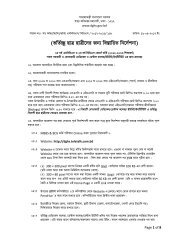EOC Newsletter June 2011
EOC Newsletter June 2011
EOC Newsletter June 2011
- No tags were found...
Create successful ePaper yourself
Turn your PDF publications into a flip-book with our unique Google optimized e-Paper software.
Table-6. Four United Nations process indicators and recommended levels for emergency obstetric careUN Process IndicatorProportion of all births atfacilityMet need for EmOCCesarean sections aspercentage of all birthsCase fatality rate (CFR)Division-wise Status of EmOC Services(January-December 2010)Proportion (%) of all Births in EmOC FacilitiesFigure-1 shows the division-wise distribution of proportion of allbirths which were taken place in health facilities in the year2010. It reveals that the proportion (%) was the highest inRajshahi division (21.66%) and the lowest in Barisal division(13.94%). The institutional delivery rates in Sylhet, Dhaka,Khulna, Rangpur, Chittagong divisions were between 20.89%and 14.05%. The average for Bangladesh was 18.44%.Figure-1. Division-wise distribution of institutionaldelivery rates [proportion (%) of all births in theEmOC facilities] (January to December 2010)19.32% 20.61% 21.66% 20.89%17.28% 18.44%13.94% 14.05%DescriptionIf less than 15% of all births in the population take place in EmOC facilities, it iscertain that some women who need lifesaving EmOC services are not receiving it.This indicator gives the proportion of women estimated to have obstetriccomplications treated at EmOC facilities. If the met need is less than 100%, one canconclude that some women with complications are not receiving the medical carethey need.Fewer than 5% cesarean sections indicate women who need cesarean sections are notreceiving it. Above 50% indicate bad medical condition or fetal condition of women.CFR measures the quality of EmOC performance at the facility level. This indicatoris thus more meaningful for taking actions locally.complications treatment rate (met need) in different EmOCfacilities in the year 2010. The rate was the highest in Dhakadivision (69.13%) and the lowest in Rangpur division(36.06%). The position of Sylhet division (63.54%) andKhulna division 53.40%) was second and third respectively.Other divisions met between 40.08% and 52.18% of theneed. On average the met need was 53.66% for wholeBangladesh.Cesarean Section as % of all BirthsFigure-3 shows the division-wise distribution of the cesareansection rates as percentage of all births taken place in theEmOC facilities in 2010. It is one of the important indicatorsfor monitoring access to C-EmOC services. It is revealed thatthe highest rate of cesarean births took place in Dhakadivision (10.06%) followed by Khulna division (8.81%). Thelowest rate was in Chittagong division (5.04%). The cesareansection rates varied from division to division. In otherdivisions, the rates were as follows: Barisal (7.15%),Rajshahi (6.06%), Rangpur (6.96%) and Sylhet (6.01%). Thecountry average was 7.61%.BarisalChittagongDhakaKhulnaRajshahiRangpurSylhetBangladeshFigure-3. Division-wise distribution of cesareansection rate (%) in the EmOC facilities by Division(January to December 2010)Met Need (%) for EmOCFigure-2 shows the division-wise distribution of obstetricFigure-2. Division-wise distribution of met need (%)of obstetric care in the EmOC facilities (January toDecember 2010)69.13%52.18%53.40%47.85%36.06%7.15%5.04%10.06%8.81%6.06%6.96%6.01%7.61%63.54%53.66%40.08%BarisalChittagongDhakaKhulnaBarisalRajshahiRangpurChittagongDhakaKhulnaRajshahiRangpurSylhetBangladeshSylhetBangladeshCase Fatality RateThe direct obstetric case fatality rate is the proportion ofwomen admitted to an EmOC facility with major direct obstetric05



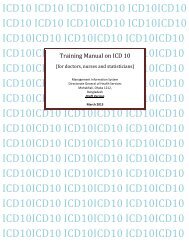



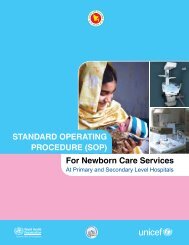
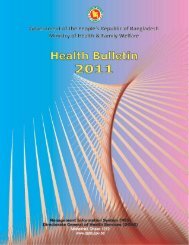
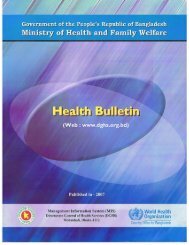
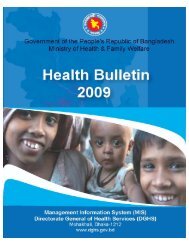
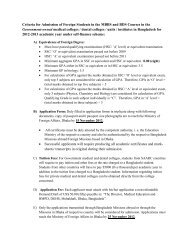
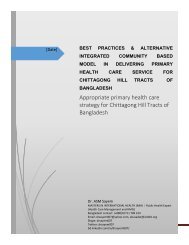
![Bangladesh Demographic and Health Survey 2007 [FR207]](https://img.yumpu.com/38440445/1/190x257/bangladesh-demographic-and-health-survey-2007-fr207.jpg?quality=85)
